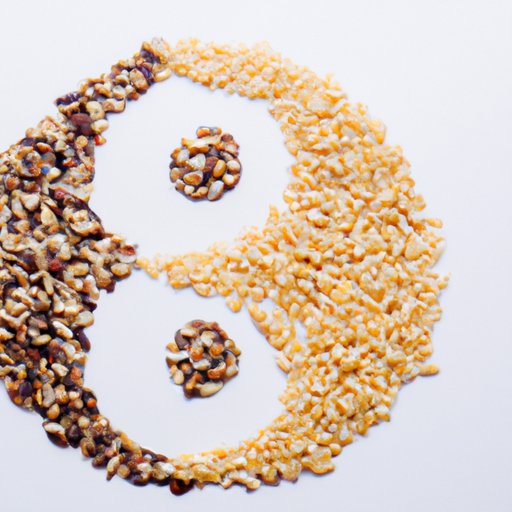
Introduction
Have you heard of the macrobiotic diet? With its growing popularity, you may be wondering what it is and whether or not it’s right for you. This article serves as a comprehensive guide to understanding the macrobiotic diet, including its basic principles and philosophy, major components, benefits, potential drawbacks, and how to transition to a macrobiotic lifestyle for optimal health.
A Comprehensive Guide to Understanding the Macrobiotic Diet: What It Is and How It Works
The macrobiotic diet is a diet that emphasizes whole grains, beans, vegetables, and sea vegetables while typically excluding meat and dairy products. The basic principles of the macrobiotic diet revolve around the concept of yin and yang, two opposite, yet complementary, forces in the universe, and balancing those forces through balanced nutrition. The macrobiotic diet has its origins in Japan, but has since spread throughout the world and has become increasingly popular in Western countries.
The major components of the macrobiotic diet include whole grains, such as brown rice, barley, and quinoa; beans, such as lentils, chickpeas, and adzuki beans; vegetables, such as leafy greens, cruciferous vegetables, and root vegetables; and sea vegetables, such as nori, hijiki, and kombu. The macrobiotic diet typically excludes meat and dairy products, although small amounts of fish, seafood, and fermented dairy products may be consumed in some macrobiotic diets.
Benefits of the macrobiotic diet may include weight loss, improved digestion, lower risk of chronic diseases, and increased energy levels. Potential drawbacks may include nutrient deficiencies if not properly planned, limited food choices, and difficulty adhering to the strict dietary guidelines.
5 Reasons Why You Should Consider Adding Macrobiotic Foods to Your Diet
There are numerous potential health benefits of incorporating macrobiotic foods into your diet. Research has shown that the macrobiotic diet may improve heart health, reduce cancer risk, improve digestion, and support a healthy gut microbiome. In addition, the macrobiotic diet provides a wide variety of nutrients that can promote overall health and wellbeing.
Macrobiotics can benefit different areas of health, including physical health, emotional health, and spiritual health. By promoting balance within the body and mind, the macrobiotic diet can help people feel more energized, focused, and connected to their inner selves.
Going Macro: How to Transition to a Macrobiotic Lifestyle for Optimal Health
If you’re interested in transitioning to a macrobiotic lifestyle, it’s important to do so gradually and with careful planning. Start by gradually incorporating macrobiotic foods into your diet and phasing out unhealthy foods. It’s also important to pay attention to your body and adjust your diet according to your individual needs.
Overcoming hurdles during the transition may include dealing with cravings for non-macrobiotic foods, managing social situations, and finding affordable and accessible macrobiotic foods. Planning meals, creating grocery lists, and utilizing cooking techniques such as steaming and stir-frying can help make the transition to a macrobiotic diet easier.
The Science Behind Macrobiotics: Understanding the Nutritional Benefits of a Macrobiotic Diet
The macrobiotic diet provides a wide range of nutrients that promote overall health and wellbeing. These nutrients include complex carbohydrates, protein, fiber, vitamins, minerals, and antioxidants. Whole grains, beans, and vegetables are rich sources of these nutrients and can provide numerous health benefits, such as reducing the risk of chronic diseases, supporting gut health, and improving cognitive function.
Macrobiotics vs. Veganism: Which is the Better Diet for You?
While both the macrobiotic and vegan diets exclude meat and dairy products, there are significant differences between the two. The macrobiotic diet emphasizes whole grains, beans, vegetables, and sea vegetables, while allowing small amounts of animal products. The vegan diet, on the other hand, excludes all animal products, including meat, dairy, eggs, and honey.
The choice between a macrobiotic and vegan diet largely depends on individual preferences, nutritional needs, and lifestyle factors. Both diets can provide numerous health benefits, but it’s important to choose a diet that meets your individual needs and promotes optimal health and wellbeing.
Macrobiotic Meal Planning: How to Create a Balanced and Nutritious Meal Plan on a Budget
Planning and preparing balanced, nutritious, and affordable meals is a crucial component of a successful macrobiotic diet. A balanced macrobiotic diet should include a variety of whole grains, beans, vegetables, and sea vegetables, along with some healthy fats and occasional animal products if desired.
To plan and prepare balanced meals on a budget, start by setting a grocery budget and making a list of macrobiotic foods that fit within that budget. Look for ways to save money, such as buying in bulk, shopping at farmers markets, and utilizing leftovers. Planning meals in advance and utilizing simple cooking techniques, such as steaming, stir-frying, and baking, can also help save time and money.
Conclusion
The macrobiotic diet is a unique and holistic approach to nutrition and health. By balancing yin and yang energies in food and promoting whole, minimally processed foods, the macrobiotic diet has the potential to improve overall health and wellbeing. With careful planning and attention to individual needs, transitioning to a macrobiotic lifestyle can be a rewarding and fulfilling journey towards optimal health.




